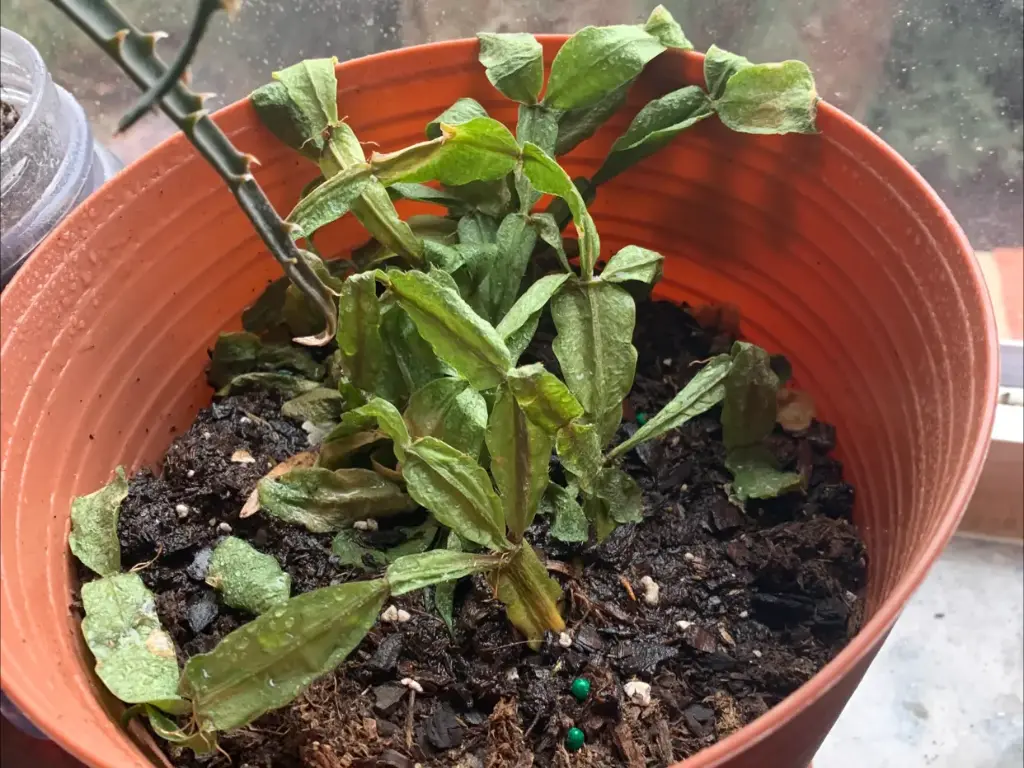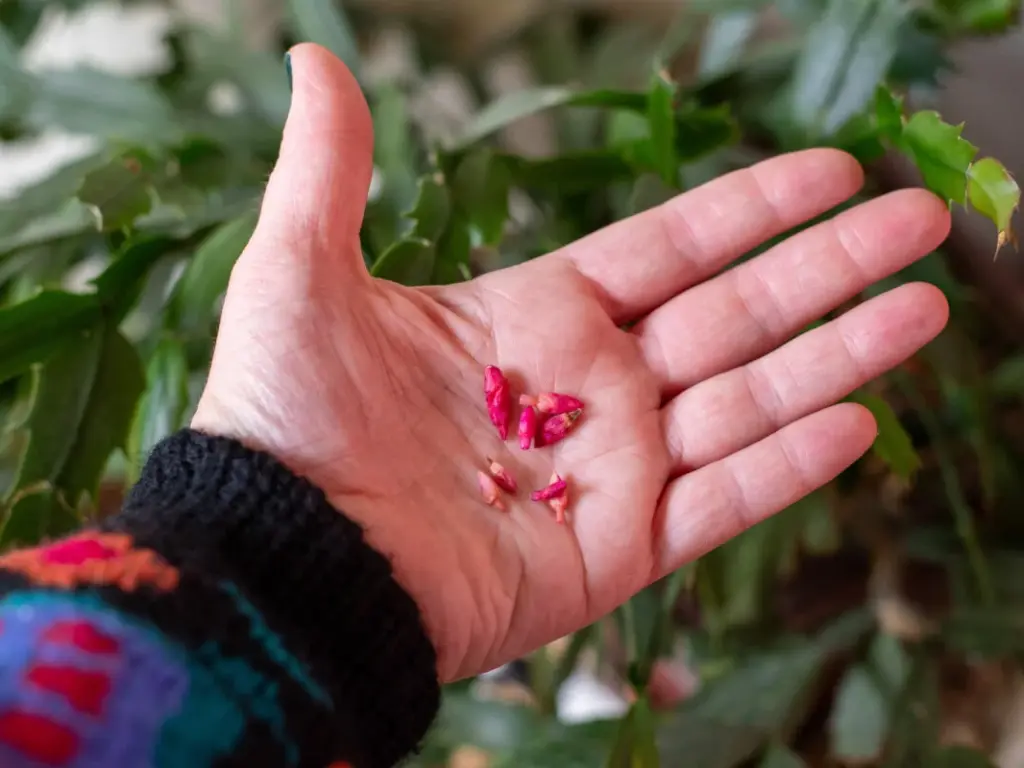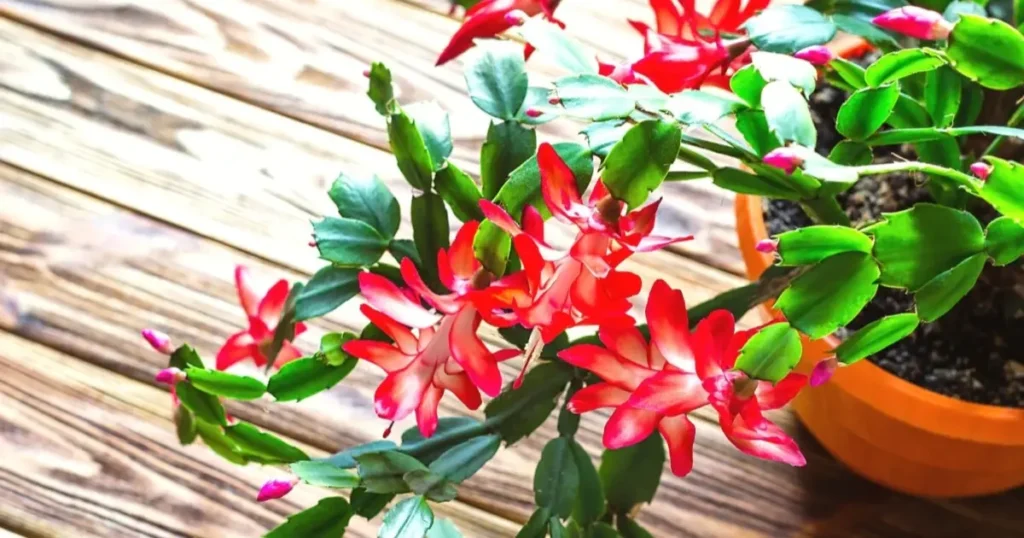Have you ever walked past your Christmas cactus and wondered why it suddenly looks sad? Maybe the leaves turned yellow overnight, the buds fell off right before blooming, or the whole plant looks limp even though you swear you did everything right. If that sounds familiar, you are not alone. Christmas cactus problems are extremely common, especially for beginners, and most issues come from simple mistakes with watering, lighting, soil, and temperature.
As a gardening blogger living in the U.S. for many years, I can tell you this: Christmas cactus (Schlumbergera bridgesii) is not a typical cactus. It does not live in dry deserts. It comes from tropical forests, and that means it reacts quickly when something is off. The good news is that almost every problem your holiday cactus faces can be fixed.
Below, we will walk through the nine most common Christmas cactus problems, how to diagnose them, and how to fix them fast so your plant can recover and bloom beautifully.
1. Overwatering and Root Rot

If your Christmas cactus has soft, mushy leaves, a sour smell from the soil, or stems that detach easily, the issue is almost always overwatering or root rot. This is the number one cause of Christmas cactus dying.
Overwatering symptoms appear because the roots sit in waterlogged soil without enough oxygen. Eventually, fungal infections develop, making the roots turn brown and mushy.
To fix an overwatered plant, start by removing it from the pot and trimming away any rotten roots. Repot it into a fresh, well-draining soil mix. A blend of regular potting mix, perlite, and orchid bark works well because it mimics the airy forest environment Christmas cactus naturally prefers.
For future watering, wait until the top third of the soil feels dry. Christmas cactus needs moisture, but not constant wetness.
2. Underwatering and Wrinkled, Limp Leaves
Underwatering is less common but still happens, especially in winter when indoor heating dries out the air. If the leaves look wrinkled, thin, or limp, the plant is dehydrated.
Fortunately, this is one of the easiest problems to fix. Water the plant thoroughly, let excess water drain out, then check it again in a few days. You should see the leaves plump back up.
If underwatering happens too often, adjust your schedule. Christmas cactus typically needs water every 7 to 10 days, depending on humidity, temperature, and light exposure.
3. Christmas Cactus Not Blooming
Many people buy a Christmas cactus for its bright holiday blooms, so it can be frustrating when it refuses to flower. The main causes are incorrect light, temperature, or watering during the blooming season.
Christmas cactus needs short days and long nights to set buds. If you keep it in a room with lights on until late, it won’t bloom.
To encourage blooming, give your plant at least six weeks of darkness for 12 to 14 hours a day. A cool room between 55°F and 65°F helps the plant form buds more quickly. Water lightly during this time to avoid bud drop.
4. Bud Drop Before Blooming

Nothing feels worse than watching your Christmas cactus develop buds only for them to fall off. Bud drop happens when the plant experiences stress during the blooming stage. The most common stress factors include temperature swings, being moved to a different location, or inconsistent watering.
Christmas cactus hates sudden changes. Once buds appear, avoid moving the plant and keep it away from drafts, heaters, or cold windows.
Maintain steady watering and keep the soil slightly moist but never soggy. Consistency is the key to keeping buds attached.
Read more: How to Prevent Christmas Cactus Bud Drop: Tips for a Healthy Bloom
5. Yellowing Leaves
Yellow leaves can appear for several reasons, but the most common is too much sunlight. Although the name includes “cactus,” this plant does not like strong direct sun. It prefers bright, indirect light.
Other causes include nutrient deficiency or poor drainage. If the leaves are turning yellow from the base upward, check for compacted soil or a pot without drainage holes. Christmas cactus needs a loose, airy mix to keep roots healthy.
You can feed the plant with a balanced, water-soluble fertilizer during the growing season to support healthy foliage.
6. Purple or Red Leaves

If your Christmas cactus leaves turn purple, it usually means the plant is experiencing light stress or cold stress. Direct sunlight, especially through a window, can cause the stems to develop a reddish or purple tint.
Cold temperatures below 50°F can also cause discoloration. Move the plant to a warmer location with gentle, indirect light. The leaves should return to a healthy green once the stress is removed.
7. Pests: Mealybugs, Spider Mites, and Fungus Gnats
These pests show up indoors more often than you might think. Mealybugs look like tiny white cotton clusters, spider mites leave fine webbing, and fungus gnats fly around damp soil.
To get rid of mealybugs or spider mites, wipe the affected areas with rubbing alcohol or use insecticidal soap. For fungus gnats, let the soil dry between waterings and use sticky traps to control adult insects.
Repotting into clean soil can help break severe infestations.
8. Improper Light Conditions
Christmas cactus needs bright, indirect light year-round. Too much direct sun can burn leaves, while too little light causes slow growth, pale foliage, and poor blooming.
A north or east-facing window works well. If your home is darker, you can use a grow light on a low setting to support winter growth.
9. Temperature and Humidity Issues
Christmas cactus thrives in moderate temperatures between 60°F and 70°F. Sudden temperature drops or exposure to cold drafts can cause stress, leaf droop, or bud drop.
Indoor heating can dry out the air in winter. If the air feels dry, increase humidity by using a pebble tray, humidifier, or grouping plants together. The plant’s tropical origins make humidity especially helpful during the growing season.
Repotting every two to three years keeps your Christmas cactus healthy. Use a pot just slightly bigger than the root ball to prevent overwatering issues. Feeding once a month during spring and summer with a balanced fertilizer encourages strong growth and better blooming.
If you want to increase the size of your plant, you can remove a few segments and propagate them in fresh soil. Christmas cactus propagates easily and makes great gifts.
Frequently Asked Questions (FAQs)
How often should I water my Christmas cactus?
Water every 7 to 10 days, but always check the soil first. Water when the top third feels dry.
Why is my Christmas cactus limp or soft?
This can be caused by overwatering, root rot, or dehydration. Check the soil and adjust your watering routine.
How can I get my Christmas cactus to bloom again?
Provide 12 to 14 hours of darkness each night, cooler temperatures, and slightly reduced watering for six weeks.
Can I revive a Christmas cactus with root rot?
Yes. Remove damaged roots, repot in fresh soil, and adjust your watering habits. Many plants recover fully.
Conclusion
Christmas cactus problems can be frustrating, especially when you’re looking forward to holiday blooms. But once you understand what your plant needs, most issues are simple to fix. Whether your cactus is dropping buds, struggling with pests, or showing signs of overwatering, the solutions are within reach. With consistent care, the right soil, proper lighting, and balanced watering, your Christmas cactus can bounce back quickly and reward you with stunning flowers year after year.
If you want to learn more about caring for houseplants or find guides on similar issues, explore related articles on succulent care, indoor plant lighting, repotting tips, and seasonal plant care. The more you understand your plants, the easier it becomes to keep them healthy and blooming.
You may like:
- 10 Best Christmas Plants to Gift This Holiday Season
- How to Propagate Christmas Cactus: Easy Methods for Thriving Holiday Plants
- How to Get Christmas Cactus to Bloom: A Festive Guide for Stunning Flowers
- Christmas Cactus Care: How to Grow Holiday Cactus
- Christmas, Thanksgiving, or Easter? How to Tell Which Holiday Cactus You Have


9 Common Christmas Cactus Problems and How to Fix Them
Have you ever walked past your Christmas cactus and wondered why it suddenly looks sad? [...]
Nov
Swedish Ivy Care: How to Grow a Healthy, Thriving Plant
Have you ever looked at your Swedish Ivy and wondered why the leaves are turning [...]
Nov
Avoid These 10 Garlic Planting Mistakes for Bigger, Healthier Bulbs
Growing garlic at home is one of the most satisfying things a gardener can do [...]
Nov
How to Prevent Christmas Cactus Bud Drop: Tips for a Healthy Bloom
Have you ever noticed your beautiful Christmas cactus (Schlumbergera) starting to lose its buds just [...]
Nov
Discover 7 Stunning Types of Night-Blooming Cereus
Have you ever waited for a flower that only opens at night and then disappears [...]
Nov
How to Propagate Comfrey from Root Cuttings: Easy Guide for Beginners
If you’re looking to grow your own healthy comfrey plants without spending too much, propagating [...]
Nov